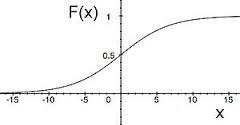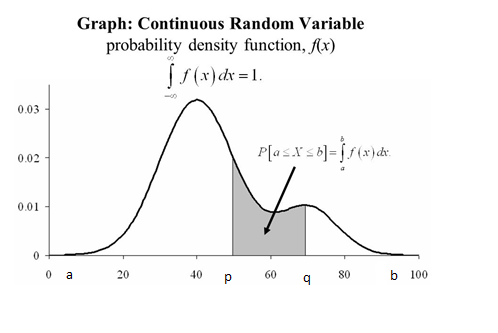Random Variables and its Probability Distributions
Table of Content |
What is a Random Variable?
A Random Variable or Stochastic Variable or Random quantity in the field of probability and statistics is a variable quantity, whose possible values depend on a set of random outcome events in random manner.
 The outcome space is defined in terms of set theory or a set.
The outcome space is defined in terms of set theory or a set.
A random variable is a function associating a real number with each outcome of a sample space S of a random experiment and it is denoted by X.
Domain of a random variable X is a sample space S and codomain or range of a random variable X is the set of real values taken by X, Thus, symbolically X: S-> R.
Types of Random Variable
There are two types of Random Variable:
-
Discrete Random Variable
-
Continuous Random Variable
Discrete Random Variable
A random variable X which can assume countable number of isolated values (integers) is called discrete random variable. The meaning of the word ‘discrete’ is separate and individual
Examples:
-
Number of attempts to hit a target
-
Number of heads in tossing a coin thrice
-
Number of stars in the sky
Continuous Random Variable
A random variable X which can assume all real values within a given interval is known as continuous random variable. Thus, the possible values of a continuous random variable are uncountably infinite.
-
Price of a commodity
-
Age of a person
-
Height of a person in cm
-
Life of an electric component (in hours)
Examples to identify random variables as either discrete or continuous in each of the following situations:
Q1. A page in a book can have at most 300 words
X= Number of misprints on a page
Solution
X = Number of misprints on a page
Since a page in a book has at most 300 words, X takes the finite values
Therefore, random variable X is discrete
Range = {0, 1, 2….299, 300}
Q2. A gymnast goes to the gymnasium regularly
X = Reduction of his weight in a month
X = Reduction of weight in a month
X takes uncountable infinite values
Therefore, random variable X is continuous.
Probability Mass Function
If X is the discrete random variable taking values x1, x2, x3…xn and we find the values of P(X = x1), P(X = x2), P(X = x3)…P(X = xn), then we obtain the functions P(x) = P(X = x) for x = x1, x2, x3…xn.
This function is called Probability Mass Function (p.m.f) of the random variable X.
Example
If two coins are tossed and X=number of heads, then the sample space of tossing two coins is {HH, HT, TH, TT}
Therefore, P(X = 0) = P (0) =1/4, P(X = 1) = P(1) = 2/4 = 1/2
P(X = 2) = P (2) = 1/4
Hence, the probability mass function is given by
P(x) = 1/4, x = 0
=1/2, x = 1
= ¼, x = 2
For the sample space S = {0, 1, 2} for X.
Note:
If X is any random variable taking values from sample space S and P(x) is the probability mass function of X such that x ∈ S, then
-
0 ≤ P(x) ≤ 1 for all x ∈ S
-
∑ P(x) = 1, that is, the total of all values of P(x) for x ∈ S is always unity.
We can verify this in the example given above
∑ P(x) = P(0) + P(1) + P(2) = 1/4 + 1/2 + ¼ =1
What is Probability Distribution?
If X is a discrete random variable taking values x1, x2, x3….xn with corresponding probabilities p1, p2, p3…pn, then the set of ordered pairs (xi, pi), i = 1, 2, 3….n is called a Probability Distribution of the random variable X.
Example
If the two coins are tossed and X is the number of heads, then the probability distribution of the random variable X can be given as below:
| X | 0 | 1 | 2 |
| P(X) | ¼ | 4-Feb | 4-Jan |
Note that the sum of all probabilities
= ¼ + 2/4 + ¼ = 4/4 = 1
In general case, the probability distribution of discrete random variable X can be given as:
| X | X1 | X2 | X3 | …. | Xn |
| P(X) | P1 | P2 | P3 | …. | Pn |
Where ∑ pi = p1 + p2 + p3 +….+ pn = 1
Cumulative Distribution Function (C.D.F) of Discrete Random Variable
Let X be a discrete random variable and its probability distribution is as follows:
| X = xi | X1 | X2 | X3 | … | Xn | Total |
| Pi = P[X = xi] | P1 | P2 | P3 | … | Pn | 1 |
The Cumulative Distribution Function (c.d.f) of X is denoted by F(x) and it is defined as
F(x) = P[X ≤ x], x ∈ R
Notes:
-
Domain of c.d.f is R
Codomain of c.d.f is [0, 1]
-
F(xi) = P[X ≤ xi] = p1 + p2 + p3 +….pi, i = 1, 2, 3,…n
-
c.d.f of a discrete random variable X is also represented in tabular form as follows:
| X=xi | F(xi) |
| X1 | P1 |
| X2 | P1+P2 |
| X3 | P1+P2+P3 |
| ……. | ……. |
| Xn | P1+P2+P3+…..+Pn |
- C.D.F. is often called Distribution Function (D. F)
Problems
Q1. Three balanced coins are tossed simultaneously. If X denotes the number of heads, find probability distribution of X.
Sol. When three balanced coins are tossed then the sample space is
{HHH, HHT, HTH, THH, HTT, THT, TTH, TTT}
X denotes the number of heads.
X can take the values 0, 1, 2, 3
P[X = 0] = P (0) = 1/8
P [X = 1] = P (1) = 3/8
P[X = 2] = P (2) = 3/8
P [X = 3] = P (3) = 1/8
Q2. Given below is the probability distribution of X:
| X | 0 | 1 | 2 | 3 | 4 |
| P [X= x] | k | 2k | 4k | 2k | k |
-
Find the value of k
-
P (X ≥ 2), P(X < 3 ), P(X≤1)
-
Obtain the c.d.f of X
Solution:
- Since P(X) is the probability distribution of X,
∑ P[X = x] =1
P[X = 0] + P[X = 1] + P[X = 2] + P[X = 3] + P[X = 4] = 1
k + 2k + 4k + 2k + k =1
10k = 1
k = 1/10
- P (X ≥ 2) = P[X = 2] + P[X = 3] + P[X = 4]
= 4k + 2k + k = 7k
= 7 (1/10) = 7/10
P (X<3) = P[X=0] +P [X=1] + P[X=2]
= k + 2k+ 4k = 7k
= 7 (1/ 10) = 7/10
P (X≤ 1) = P[X=0] + P [X=1]
= k +2k = 3k
= 3 (1/10) = 3/10
- By definition of C.D.F,
F(x) = P (X ≤ x)
F(0) = P (X ≤ 0) = P(0) = k = 1/10
F(1) = P(X ≤ 1) = P(0) + P(1) = k + 2k = 3k = 3/10
F(2) = P(X ≤ 2) = P(0) + P(1) + P(2) = k + 2k + 4k = 7k = 7/10
F(3) = P(X ≤ 3) = P(0) + P(1) + P(2) + P(3) = k + 2k + 4k + 2k = 9/10
F(4) = P(X ≤ 4) = P(0) + P(1) + P(2) + P(3) + P(4) = k + 2k + 4k + 2k + k = 10/10 = 1
Hence, the c.d.f of X is as follows:
| xi | 0 | 1 | 2 | 3 | 4 |
| F(xi) | 10-Jan | 10-Mar | 10-Jul | 10-Sep | 1 |
Probability Density Function (P. D. F) and Distribution Function (D. F) of a Continuous Random Variable
Probability Density Function
A real valued function f(x) is called a Probability Density Function (P. D. F) of a continuous random variable X, if it satisfies the following:
-
F(x) ≥ 0 for all x ∈ R

Notes:
-
If X takes the values in the interval (a,b) then the function f(x) is such that
-
F(x) ≥ 0 for a < x < b, and
-
∫ba f(x) dx =1
-
- The geometrical representation is as below:
The area under the curve y= f(x) bounded by the X-axis and the coordinates x = a and x = b is 1, because it represents the total probability P(a< X <b) which is equal to 1.
Also, P (p < X < q) is area under the curve y = f(x) bounded by the X-axis and the coordinates x = p and x = q which is shaded in the figure.
The graph of the P. D. F of R. V. X is called the Probability Curve or Probability Density Curve.
Distribution Function
Assume X as a continuous random variable with probability density function f(x), then the cumulative distribution function F(x)of X is defined for every real number xi, as F(xi) =P [X ≤ xi] = ∫ f(x) dx
Remarks:
-
 F(xi) is the area under the curve y= f(x) to the left of x as shown in the figure right:
F(xi) is the area under the curve y= f(x) to the left of x as shown in the figure right: -
F(x) increases smoothly as x increases
-
If range of X is (a,b) then F(x) = 0, for x< a and F(x) = 1, for x≥b
-
P [X >x]=1 - P [X ≤ xi]= 1- F(x)
More Readings

